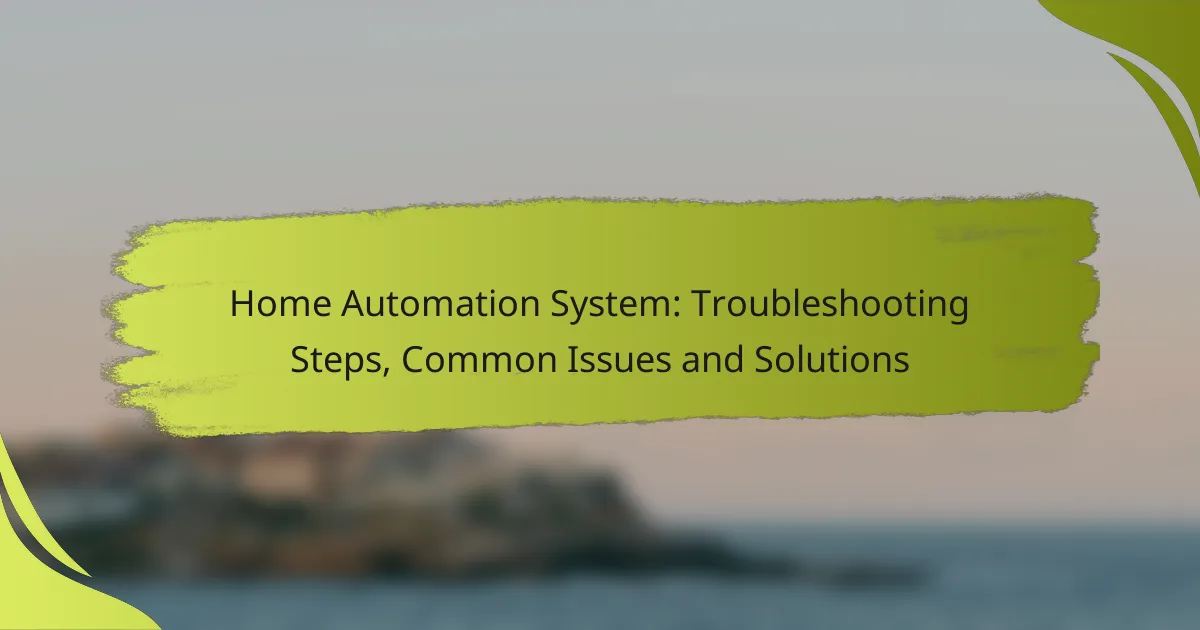Home automation systems can enhance convenience and efficiency, but they often encounter common issues such as connectivity problems, device compatibility challenges, and software glitches. Understanding these potential hurdles is essential for effective troubleshooting and maintaining a smooth smart home experience. By following systematic steps, users can quickly identify and resolve issues to ensure their devices function harmoniously.
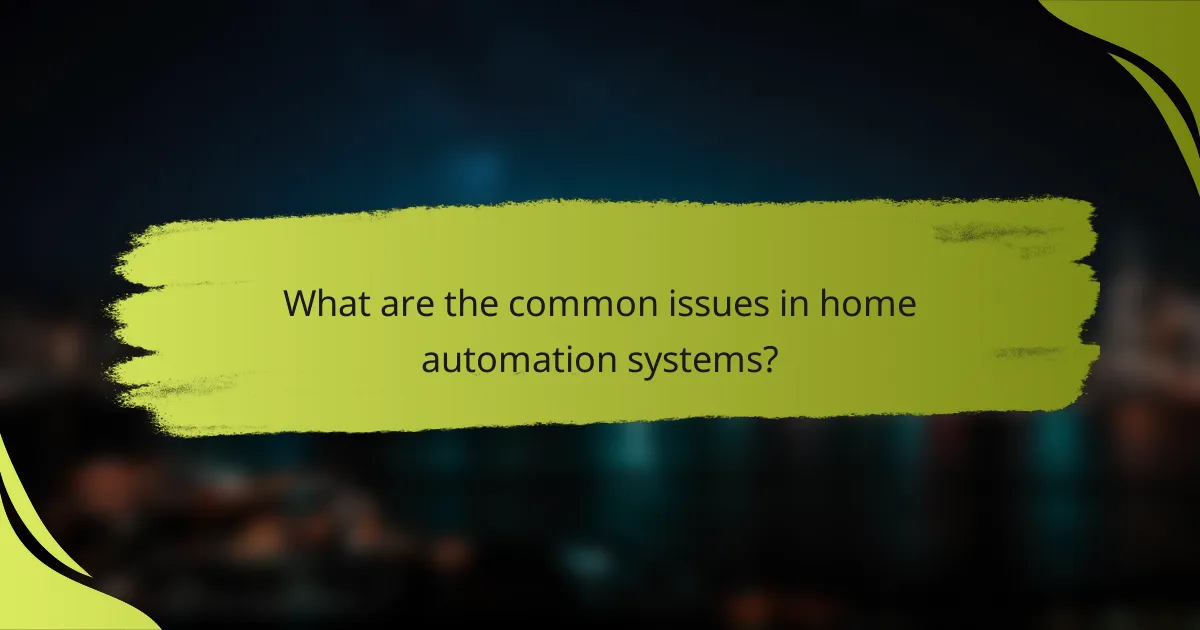
What are the common issues in home automation systems?
Common issues in home automation systems include connectivity problems, device compatibility issues, power supply failures, software glitches, and sensor malfunctions. Understanding these challenges can help users troubleshoot effectively and maintain a seamless smart home experience.
Connectivity problems
Connectivity problems often arise from weak Wi-Fi signals or network congestion, impacting the performance of smart devices. Ensuring that your router is centrally located and not obstructed can significantly improve connectivity.
To troubleshoot, check the signal strength in various areas of your home. Consider using Wi-Fi extenders or mesh networks if devices are located far from the router.
Device compatibility issues
Device compatibility issues occur when different brands or models of smart devices do not work well together. This can be due to varying communication protocols, such as Zigbee, Z-Wave, or Wi-Fi.
Before purchasing new devices, verify their compatibility with your existing system. Using a central hub that supports multiple protocols can help mitigate these issues.
Power supply failures
Power supply failures can disrupt the operation of home automation devices, leading to unexpected shutdowns. This can be caused by faulty power adapters, dead batteries, or tripped circuit breakers.
Regularly check the power sources of your devices and replace batteries as needed. If devices are hardwired, ensure that circuit breakers are functioning properly and that there are no loose connections.
Software glitches
Software glitches may manifest as unresponsive devices or features that do not work as intended. These issues can stem from outdated firmware or software conflicts.
To resolve software glitches, keep all devices updated with the latest firmware. Restarting devices or performing a factory reset can also help clear temporary issues.
Sensor malfunctions
Sensor malfunctions can lead to inaccurate readings or failure to trigger automation routines. Common causes include dirt on the sensor, low battery levels, or environmental factors affecting performance.
Regularly clean sensors to ensure accurate readings and replace batteries as needed. If issues persist, consider recalibrating the sensors or consulting the manufacturer’s guidelines for troubleshooting steps.
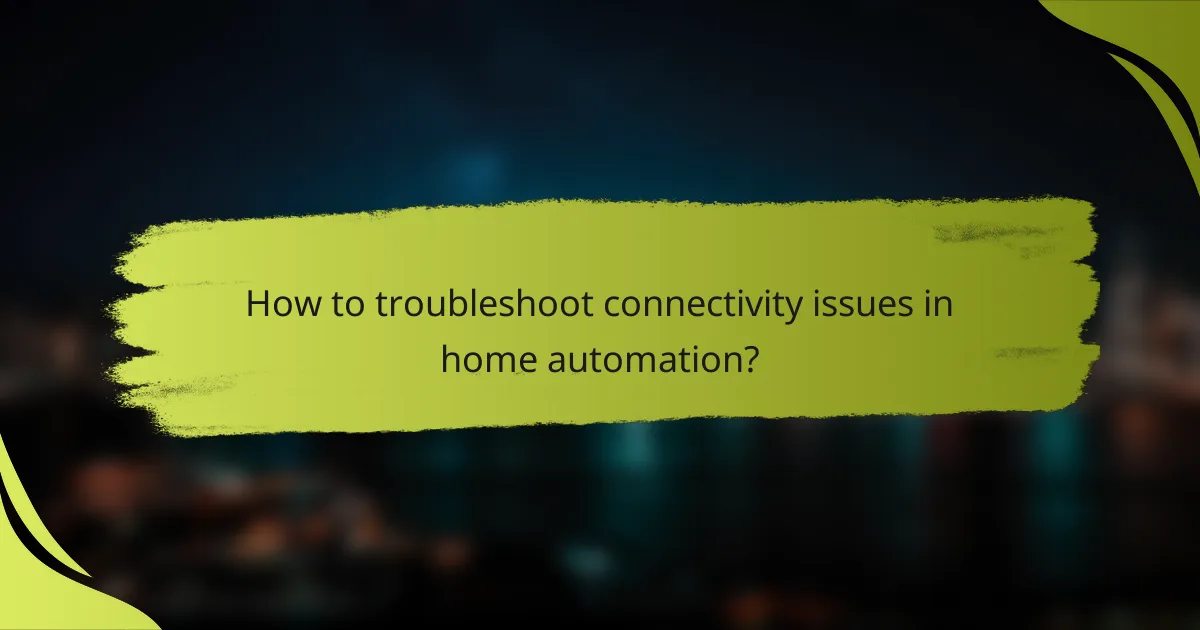
How to troubleshoot connectivity issues in home automation?
Troubleshooting connectivity issues in home automation involves identifying and resolving problems that prevent devices from communicating effectively. Common steps include checking Wi-Fi signal strength, restarting the router, and updating firmware to ensure smooth operation.
Check Wi-Fi signal strength
A strong Wi-Fi signal is crucial for the reliable operation of home automation devices. Use a smartphone or a laptop to check the signal strength in areas where devices are located. Ideally, the signal should be at least -70 dBm for optimal performance.
If the signal is weak, consider relocating the router to a more central position or using Wi-Fi extenders to boost coverage. Avoid placing the router near thick walls or metal objects that can interfere with the signal.
Restart the router
Restarting the router can resolve many connectivity issues by refreshing the network connection. To do this, unplug the router, wait for about 30 seconds, and then plug it back in. This simple step can often restore connectivity to home automation devices.
Make it a habit to restart your router periodically, especially if you notice slow performance or dropped connections. Regular reboots can help maintain a stable network environment.
Update firmware
Keeping your router and home automation devices updated with the latest firmware is essential for security and performance. Check the manufacturer’s website or the device’s app for available updates and follow the instructions to install them.
Firmware updates can fix bugs, improve connectivity, and enhance device compatibility. Schedule updates during off-peak hours to minimize disruption to your home automation system.

What are the steps to resolve device compatibility issues?
To resolve device compatibility issues in a home automation system, start by identifying the protocols supported by your devices. Ensuring that all components can communicate effectively is crucial for seamless integration.
Verify supported protocols
Check the specifications of each device to confirm which communication protocols they support, such as Zigbee, Z-Wave, or Wi-Fi. Compatibility often hinges on these protocols, so ensure that all devices can operate on the same network standard.
For example, if you have a smart light bulb that uses Zigbee, it will not work with a hub that only supports Z-Wave. Refer to the product documentation for detailed compatibility information.
Update device firmware
Firmware updates can resolve many compatibility issues by improving device performance and fixing bugs. Regularly check for updates from the manufacturer’s website or through the device’s app.
To update, follow the manufacturer’s instructions, which typically involve downloading the latest firmware and applying it through the device’s settings. This process can take a few minutes but is essential for optimal functionality.
Consult manufacturer guidelines
Manufacturer guidelines provide critical information about device compatibility and setup. Review the user manuals or online resources for each device to understand any specific requirements or limitations.
Additionally, many manufacturers have customer support services that can assist with compatibility questions. Don’t hesitate to reach out if you encounter persistent issues, as they may have solutions tailored to your specific setup.
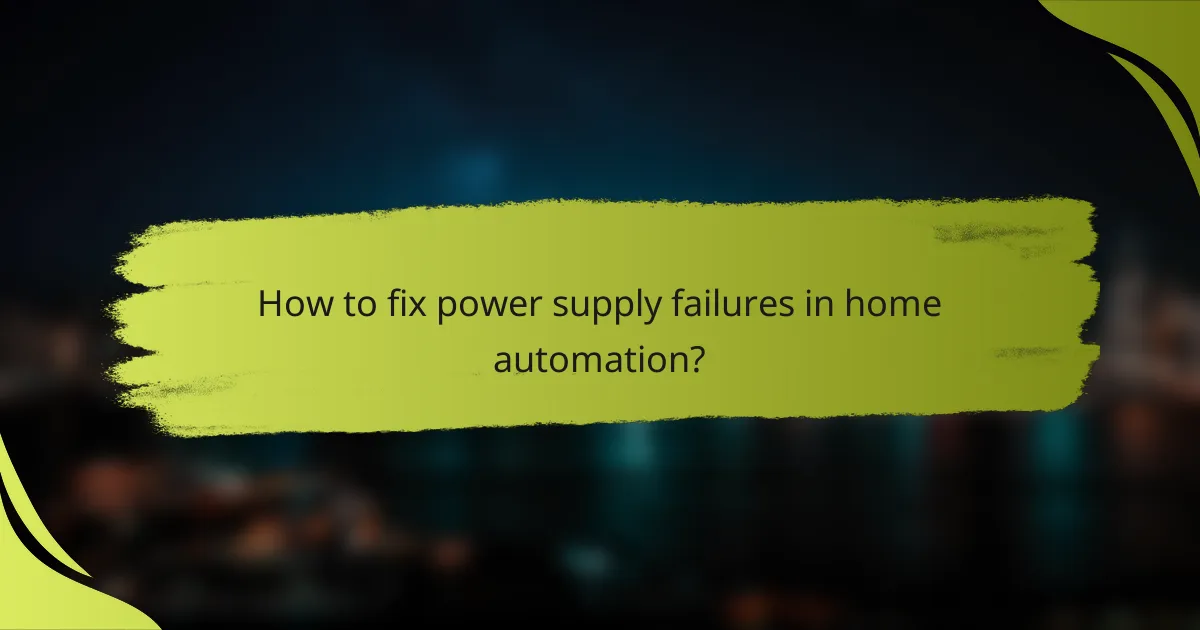
How to fix power supply failures in home automation?
To resolve power supply failures in home automation systems, start by identifying the source of the issue, which often involves checking power sources, batteries, and circuit breakers. Addressing these areas can restore functionality and prevent future disruptions.
Inspect power sources
Begin troubleshooting by examining all power sources connected to your home automation system. Ensure that devices are plugged into functioning outlets and that any power strips or surge protectors are operational. If using a wired system, check for loose connections or damaged cables.
For wireless devices, confirm that the Wi-Fi network is stable and that the router is powered on. A weak or intermittent connection can lead to perceived power failures, so consider rebooting your router if issues persist.
Replace faulty batteries
Battery-operated devices in your home automation system may require new batteries if they are not functioning. Check the battery levels and replace any that are low or dead, using high-quality batteries that match the manufacturer’s specifications.
Keep a stock of common battery types on hand, such as AA or CR123A, to minimize downtime. Regularly scheduled maintenance, including battery checks, can help prevent unexpected failures.
Check circuit breakers
If your home automation system is hardwired, inspect the circuit breakers to ensure they haven’t tripped. A tripped breaker can cut power to your devices, leading to failures. Reset any tripped breakers by switching them off and then back on.
Consider labeling your circuit breakers for easy identification of which ones control specific areas of your home automation system. If breakers frequently trip, it may indicate an overload or a fault in the wiring, which should be addressed by a qualified electrician.

What are the solutions for software glitches in home automation?
To resolve software glitches in home automation systems, consider rebooting the system, resetting it to factory settings, or installing software updates. These steps can help restore functionality and improve performance.
Reboot the system
Rebooting your home automation system is often the quickest and simplest solution for software glitches. This process clears temporary files and resets connections, which can resolve minor issues. To reboot, simply power off the device, wait for a few seconds, and then turn it back on.
For systems with multiple components, ensure to reboot each device in the network. This can help re-establish communication between devices and restore normal operation.
Reset to factory settings
If rebooting does not resolve the issue, consider resetting the system to factory settings. This action restores the original configuration, removing any custom settings that may be causing problems. Be aware that this process will erase all user data and preferences, so it should be used as a last resort.
To perform a factory reset, consult the user manual for specific instructions, as the method can vary by manufacturer. After the reset, you will need to reconfigure the system and reconnect any devices.
Install software updates
Installing software updates is crucial for maintaining the performance and security of your home automation system. Manufacturers frequently release updates to fix bugs, improve functionality, and enhance security features. Regularly check for updates through the system’s app or settings menu.
To ensure a smooth update process, connect your system to a stable internet connection and follow the prompts carefully. If updates are available, install them promptly to minimize potential vulnerabilities and glitches.
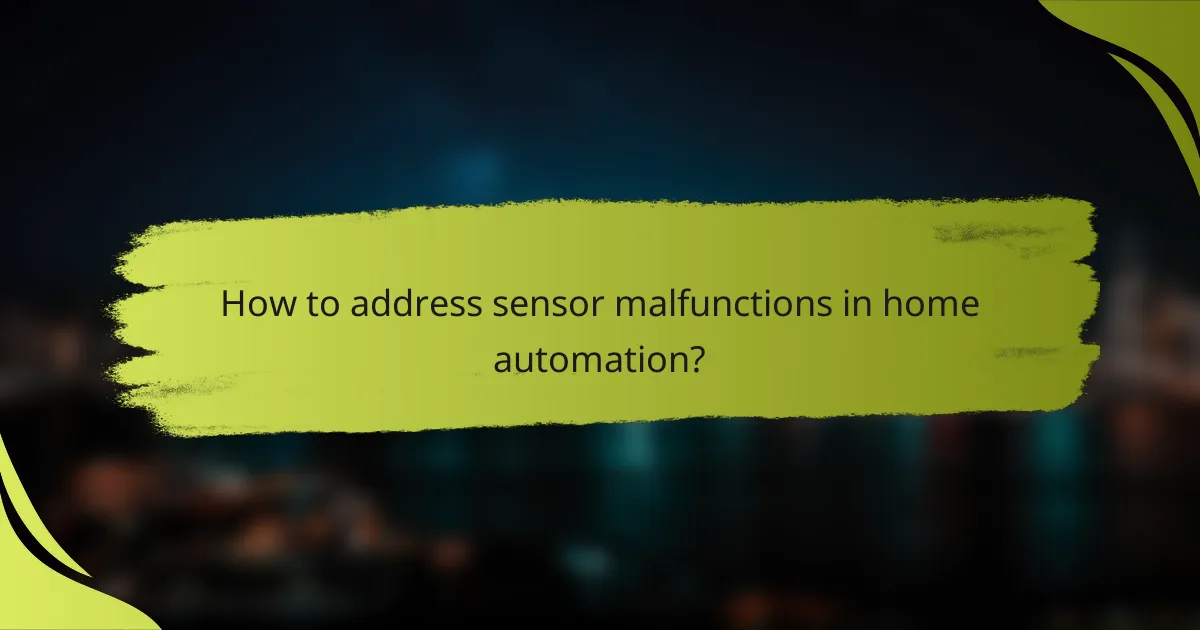
How to address sensor malfunctions in home automation?
To address sensor malfunctions in home automation, start by identifying the specific issue affecting the sensor’s performance. Common problems include calibration errors, connectivity issues, or physical obstructions that can interfere with sensor readings.
Calibrate sensors
Calibrating sensors is essential for ensuring accurate readings in your home automation system. This process involves adjusting the sensor settings to align with the actual environmental conditions, which can vary over time due to factors like temperature changes or physical wear.
To calibrate a sensor, refer to the manufacturer’s guidelines, which typically outline the steps required. For example, some sensors may need to be reset or adjusted using a companion app or physical controls. Regular calibration can help maintain performance and reliability.
Be cautious of common pitfalls during calibration, such as failing to account for environmental changes or neglecting to follow the manufacturer’s instructions. A good practice is to check sensor calibration every few months or after significant changes in the environment, ensuring your home automation system operates optimally.
